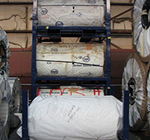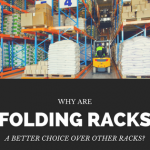Advantages and Disadvantages of Narrow Aisle Pallet Racking
In the ever-evolving landscape of warehouses and storage facilities, optimizing space while maintaining operational efficiency is crucial. Narrow Aisle Pallet Racking (NAPR) has emerged as a popular solution, offering a balance between space utilization and accessibility.
In the ever-evolving landscape of warehouses and storage facilities, optimizing space while maintaining operational efficiency is crucial. Narrow Aisle Pallet Racking (NAPR) has emerged as a popular solution, offering a balance between space utilization and accessibility. Let’s understand the advantages and disadvantages of Narrow Pallet Racking to provide a comprehensive understanding of its impact on warehouse operations.

Advantages of Narrow Aisle Pallet Racking Systems
Space Optimization
One of the primary advantages of NAPR is its ability to maximize vertical space within a warehouse. By narrowing the aisles between racks, these systems allow for more aisles to be created, resulting in increased storage capacity. This is particularly beneficial for facilities with limited square footage, enabling them to store a larger volume of goods without expanding the physical footprint.
Increased Storage Density
Narrow Pallet Racking systems facilitate higher storage density compared to traditional racking systems. The reduced aisle width means that more pallet positions can be accommodated within the same floor space. This density is especially advantageous for storing a large number of SKUs (Stock Keeping Units) in a single location, improving inventory management and accessibility.
Selective Accessibility
While the aisles are narrower, NAPR systems often incorporate specialized forklifts, such as turret trucks or reach trucks. These forklifts are designed to navigate within narrow spaces efficiently. Despite the reduced aisle width, the selective accessibility feature allows for precise picking and retrieval of pallets. This results in faster and more accurate order fulfillment, enhancing overall warehouse productivity.
Improved Stock Rotation
Narrow Pallet Racking promotes efficient stock rotation due to its selective accessibility. With the ability to easily access specific pallets within the racks, warehouses can implement a first-in, first-out (FIFO) inventory management system. This ensures that older stock is used before newer stock, reducing the risk of product obsolescence and minimizing waste.
Cost Savings
The space-saving design of NAPR systems not only optimizes storage capacity but also contributes to cost savings. By making better use of available space, warehouses may avoid the need for costly expansions or additional facilities. Furthermore, the efficient use of space can lead to reduced energy consumption, as lighting, heating, and cooling requirements are proportionally lower in a well-organized, compact space.
Disadvantages of Narrow Aisle Pallet Racking Systems
High Initial Investment
Implementing Narrow Aisle Pallet Racking systems requires a significant upfront investment. This includes the cost of specialized forklifts, rack structures, and the necessary infrastructure modifications to accommodate the narrower aisles. While the long-term benefits may outweigh the initial costs, it’s crucial for businesses to carefully consider their budget constraints before opting for this storage solution.
Forklift Limitations
The efficient operation of NAPR systems relies heavily on the use of specialized forklifts that can navigate narrow aisles. These forklifts are generally more expensive than standard ones and may require additional training for operators. Moreover, if a facility already owns a fleet of conventional forklifts, the transition to NAPR may involve a significant capital investment in new equipment.
Reduced Throughput Speed
While Narrow Racking excels in space optimization, the trade-off is often a reduction in throughput speed. The narrow aisles, combined with the need for precision in maneuvering specialized forklifts, may slow down the movement of goods within the warehouse. This can be a drawback for facilities with high-volume, time-sensitive operations.
Limited Flexibility
NAPR systems are designed for specific pallet dimensions and forklift types. This can limit the flexibility of a warehouse in handling various pallet sizes or adapting to changes in product dimensions over time. If a business experiences shifts in its product line or packaging requirements, it may face challenges in accommodating these changes within the existing NAPR infrastructure.
Maintenance and Repairs
The complexity of Narrow Aisle Pallet Racking systems, particularly the specialized forklifts, may lead to higher maintenance and repair costs. Regular upkeep and periodic inspections are essential to ensure the smooth functioning of the system. Downtime due to maintenance activities can impact overall warehouse efficiency, making it crucial for businesses to factor in these considerations when adopting NAPR.
Safety Considerations: Ensuring the Well-being of Workers and Assets
In the realm of warehousing and storage, safety is paramount. As warehouses transition to or consider implementing Narrow Aisle Pallet Racking (NAPR) systems, it is crucial to delve into the specific safety considerations associated with this space-efficient storage solution.
Forklift Safety: Specialized forklifts, such as turret trucks or reach trucks, are integral components of Narrow Aisle Pallet Racking systems. These forklifts are designed to navigate within narrow spaces, but the potential for collisions with racks or other equipment is heightened. Adequate training for forklift operators is essential to mitigate the risk of accidents. Additionally, establishing and strictly enforcing speed limits within the narrow aisles contributes to a safer working environment.
Aisle Clearances: While the design of NAPR systems aims to maximize storage density by narrowing aisles, it is crucial to maintain sufficient clearance for both forklifts and personnel. In the event of an emergency or the need for quick evacuation, having clear and unobstructed aisles ensures the safety of workers. Striking the right balance between space optimization and aisle clearances is fundamental to preventing accidents and injuries.
Rack Stability and Inspection: The stability of the racking structures is paramount to the overall safety of the NAPR system. Regular inspections of the racks, including checking for signs of wear, damage, or misalignment, are essential. Any compromised rack integrity should be promptly addressed to prevent the risk of collapse, which can lead to injuries, damage to goods, and operational disruptions.
Emergency Protocols: Implementing and regularly practicing emergency protocols is crucial in any warehouse setting, but it takes on added significance in Narrow Racking environments. Clear evacuation routes, emergency exit signage, and communication systems should be in place. Employees should be well-versed in emergency procedures, and regular drills should be conducted to ensure a swift and coordinated response in case of unforeseen events.
Training Programs: Comprehensive training programs for both forklift operators and warehouse personnel are essential components of a safe NAPR environment. Training should cover not only the operation of specialized forklifts but also safe working practices within narrow aisles. Heightened awareness of potential hazards, proper load handling techniques, and adherence to safety guidelines contribute to a culture of safety within the warehouse.
Lighting and Visibility: Adequate lighting is critical in narrow aisles to enhance visibility for forklift operators and warehouse staff. Poor lighting conditions can lead to accidents, particularly during tasks that require precision, such as pallet retrieval or stacking. Regular maintenance of lighting fixtures and ensuring uniform illumination throughout the storage area are key considerations in promoting a safe working environment.
Personal Protective Equipment (PPE): The use of appropriate personal protective equipment is a fundamental aspect of ensuring the well-being of workers in a NAPR environment. This may include high-visibility vests, hard hats, and steel-toed boots. By providing and mandating the use of PPE, warehouses can reduce the risk of injuries and create a safer workplace.
Integration of Safety Technologies: Advancements in technology have led to the development of safety features and systems that can enhance the overall safety of Narrow Pallet Racking environments. These may include proximity sensors, anti-collision systems, and automated monitoring tools. Integrating such technologies into the NAPR system can provide an additional layer of protection against accidents and improve overall operational safety.
Conclusion
Narrow Racking is a storage solution that has gained popularity for its ability to optimize space and improve storage density in warehouses. While it offers significant advantages, such as space utilization and selective accessibility, businesses must carefully weigh these benefits against the associated disadvantages.
The decision to implement Narrow Aisle Pallet Racking should be based on a thorough assessment of the specific needs and constraints of the warehouse. Factors such as budget considerations, the nature of the stored goods, and the operational requirements play a crucial role in determining the suitability of NAPR for a particular facility. Ultimately, when implemented thoughtfully and in alignment with the operational demands of a warehouse, Narrow Pallet Racking can be a strategic investment that enhances storage efficiency, streamlines inventory management, and contributes to overall cost savings. As the logistics industry continues to evolve, finding the right balance between space optimization and operational agility remains key to achieving sustainable growth and competitiveness in the marketplace.
Frequently Asked Questions About Narrow Racking
What is the Recommended Size of Narrow Pallet Racking Aisle Width?
The recommended narrow pallet racking aisle width is normally determined by the type of forklift utilized and the pallet dimensions. However, as an overall guideline:
- Reach trucks: Reach trucks are widely employed in short aisle warehouses, with aisle widths ranging from 8 to 10 feet (2.4 to 3 meters).
- Very Narrow Aisle (VNA) Trucks: VNA trucks are built for even narrower aisles, which can be as narrow as 5 to 6 feet (1.5 to 1.8 meters).
It’s crucial to note that these are only basic guidelines; your warehouse’s specific requirements may differ depending on factors such as pallet size, forklift mobility, and any safety standards or recommendations in your area. Always seek advice from a warehouse design professional or your forklift manufacturer for accurate recommendations adapted to your individual requirements.
What is the Difference between very narrow and narrow racking?
Narrow racking has larger aisles, which typically range from 8 to 10 feet. These systems can accept typical forklifts, such as sit-down counterbalance or reach trucks, which have a larger turning radius. While narrow aisle arrangements provide more storage density than standard broad aisle setups, they nevertheless allow for rather ample forklift maneuverability.
Very narrow aisle (VNA) racking systems, on the other hand, are designed for even tighter locations, with aisles typically measuring 5 to 6 feet in width. These short lanes increase storage density even more, making them suitable for warehouses with limited floor space. The trade-off is that VNA systems necessitate the use of specialized forklifts, such as turret trucks or man-up order pickers, which are specifically designed to navigate these narrow aisles.
What is the OSHA requirement for Narrow Aisle Racking?
OSHA (Occupational Safety and Health Administration) establishes standards for narrow aisle racking to guarantee worker safety. While particular criteria might vary depending on things such as company type and individual conditions, below are some broad guidelines that OSHA normally mandates for narrow aisle racking:
- Aisle Width: OSHA typically mandates a minimum aisle width for safe navigation of equipment like forklifts or pallet jacks. The specific width may vary depending on the type of equipment used and the configuration of the racking system.
- Load Capacity: OSHA requires that narrow aisle racking systems are designed and installed to safely support the intended loads. This includes considering factors such as weight distribution, load placement, and the structural integrity of the racking components.
- Clearance Height: There are often requirements for minimum clearance heights above the racking system to prevent overhead collisions and ensure worker safety.
- Inspections: OSHA typically requires regular inspections of narrow aisle racking systems to identify and address any potential hazards or structural issues. These inspections may be conducted by trained personnel or qualified inspectors.
- Training: OSHA often mandates that workers who operate equipment in narrow aisle racking areas receive proper training on safe operating procedures, including how to navigate narrow aisles, load and unload materials safely, and recognize potential hazards.
Should Narrow Pallet Racking be Bolted on Floor?
Yes, it is often advised to bolt thin pallet racking to the floor for stability and safety reasons. Bolting the racking to the floor prevents it from tipping over or shifting, particularly when laden with big pallets. This anchoring gives an extra degree of protection, lowering the danger of accidents while also ensuring the storage system’s integrity. Furthermore, anchoring the racking to the floor helps to evenly distribute the load’s weight, which improves stability even further.
About The Author










